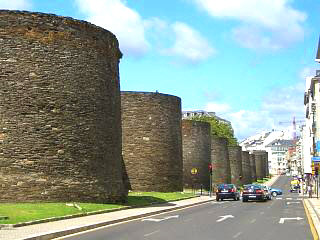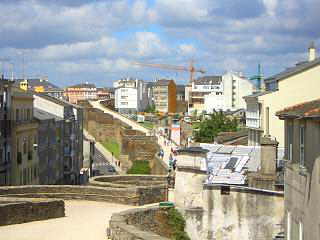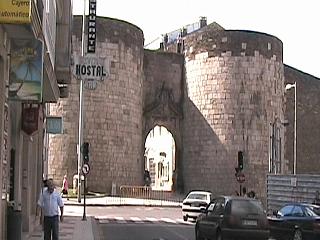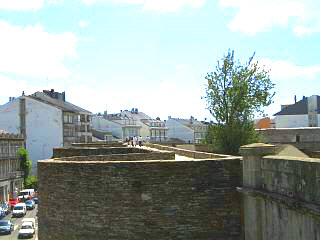Lugo's Roman wall (Muralla Romana)
Even today, almost 1700 years after it was first built, Lugo's Roman wall is still a
defining and un-missable feature of the city.
 Constructed over a period of 45 years between 265 AD and 310 AD the wall is over 2km in circumference and completely encircles the old town.
Constructed over a period of 45 years between 265 AD and 310 AD the wall is over 2km in circumference and completely encircles the old town.
The picture to the left indicates the scale of this impressive Roman structure with its many curved turrets.
Today the walls no longer have the moat and "intervallum" that formed such an important part of their defensive structure in days of old, but it is not difficult to imagine how intimidating they must have appeared to a potential aggressor.
Some details about Lugo's wall
The wall has a total length of almost one and a half miles and varies between 8 metres and 12 metres in thickness. At its highest level the wall is about thirty five feet (12 metres) tall and is in the unusual shape (in plan) of a quadrangle. The original wall had five Roman
 gates, not the ten of today, and was built using a traditional roman mortar which made use of locally available gravel stone, mud and possibly a small quantity of lime.
gates, not the ten of today, and was built using a traditional roman mortar which made use of locally available gravel stone, mud and possibly a small quantity of lime.
To the right, a view taken from the top of the wall, showing how it snakes its way around the original Roman settlements boundary. The old town of Lugo is to the right of the wall.
The original Roman gates are, the Mina (or Carmen), the Neuva (or new), the Falsa (false), the San Pedro (or Toledana) and the Santiago (or Puxigo's) gates. The other five, and more recent, gates resulted from the development of the town and its ever increasing need for points of ingress.

Visually, Lugo's Roman wall is dissimilar to another famous and intact Roman wall, namely the one found in the English city of York (the largest and most complete of all the Roman city walls). It is constructed in a much more random masonry style and makes use of blocks with a long but narrow face. Those of York are considerably deeper and larger and, combined with the lighter coloured stone, result in two walls with completely different appearances. Both no doubt reflect not just the locally available materials, but also the craftsmanship, tradition and style of building that was prevalent at the time.
Lugo's wall has many curved turrets (82 out of the original 85 still remain) and two significant towers, both of which have two separate levels. The entire wall, turrets and towers, were heavily fortified and produced what must have been a near impenetrable barrier to all potential attackers. Below, one of the many turrets that bellow out from the main wall.

Access stairs that take modern day visitors to the top of the wall are not original, neither are the paved and graveled surfaces that they now walk on. This becomes obvious when you realize that the views and sights that the wall now affords would have made any defender highly vulnerable during attack. It is therefore likely that the present plane of the walls foot-way would have been lower and that the level of the walls battlements would have been higher. Evidence to support this exists in the form of the "Mosqueira" tower with its arched windows. This suggests that there may once have been an additional one or two storeys of masonry above the walkway level of the walls that we see today.

Lugo's Roman wall has national monument status and is supported by the Galician Xunta (parliament) which has invested in restorations and refurbishments. When you look at the wall from outside the old town it is neatly framed by green lawns that extend out from the base and also hold spot lighting from which the wall is illuminated at night. Today the wall stands as a testament to the long saga of this Roman-Galician city and the history that prevails around it.
Back to the Lugo main index page.

